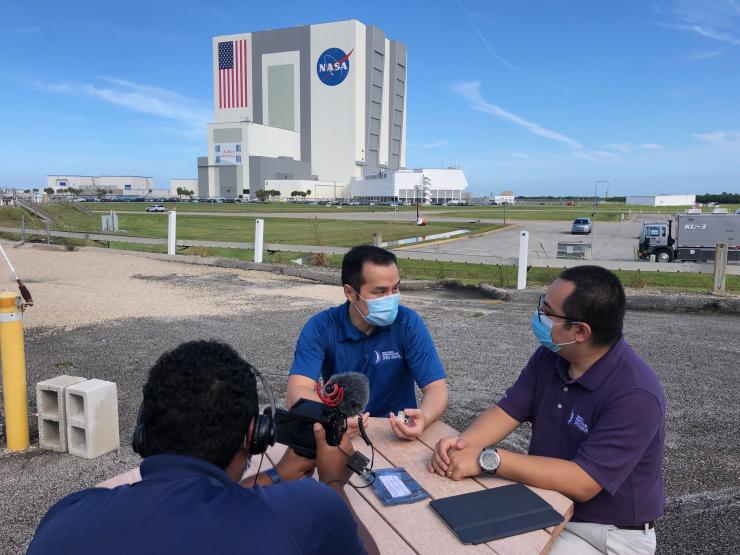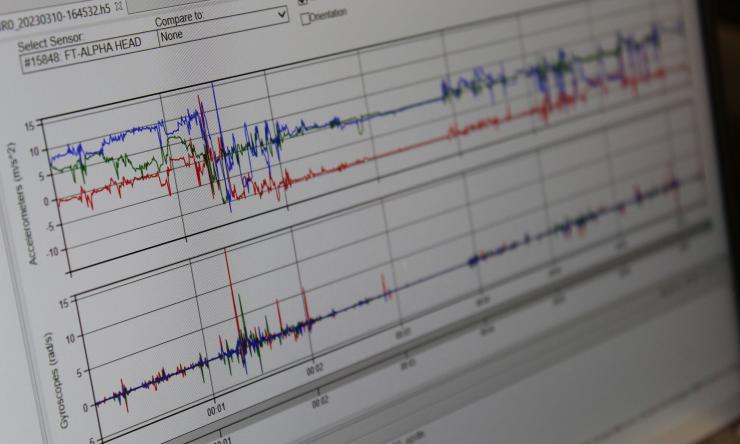EXPAND Program

The Translational Research Institute for Space Health (TRISH) established the first-of-its-kind research platform to study human health and performance in private spaceflight participants in 2021. Working with commercial spaceflight providers and their passengers, the TRISH EXPAND (Enhancing eXploration Platforms and Analog Definition) Program collects pre-, in-, and post-flight health and performance data from multiple commercial space flights.
EXPAND research addresses a wide range of challenges that humans face on long-duration space missions: early detection and treatment of medical conditions, protection from radiation effects, behavioral health, team dynamics, and more. TRISH pioneered a way to combine the studies of multiple researchers to streamline the process for spaceflight participants. The first commercial spaceflight carrying TRISH EXPAND health research was the three-day-long Inspiration4 mission.
In addition to new experiments, TRISH provides a state-of-the-art integrated medical and environmental research knowledge bank as well as a repository for biological samples. EXPAND captures research, medical data and biospecimens from all volunteering commercial spaceflight participants. The data and biosamples are housed in the EXPAND Database and Biorepository, a centralized research database at Baylor College of Medicine. TRISH selected TrialX to build the Expand Database Portal.
EXPAND Research On Commercial Space Missions
TRISH announced it would be conducting six human health and performance research projects to be conducted aboard the Fram2 human spaceflight mission. TRISH’s research projects will evaluate the human body’s response to spaceflight and the space environment, including changes to cognitive function, impacts of increased radiation exposure and physiology. Subsequent data findings will be used to develop new technologies to enhance human health and performance during spaceflight missions, including future missions to the moon and Mars. Fram2 launched March 31, 2025.
The Science
Cognitive and Physiologic Responses in Commercial Space Crew on Short-Duration Missions
Principal Investigator: Mathias Basner, M.D., Ph.D., M.S., University of Pennsylvania Perelman School of Medicine
Spaceflight participants experience a multitude of stressors that can affect brain function and crew physiology. Basner’s team will track spaceflight participants’ cognitive performance including memory, spatial orientation and attention before, during and after the mission to assess the mental impact of space travel. Participants also will wear a Garmin smartwatch and a BioIntelliSense BioButton® medical grade device that may inform any changes in cognitive performance.
Otolith and Posture Evaluation II
Principal Investigator: Mark Shelhamer, Sc.D., Johns Hopkins University
Many space travelers develop motion sickness, nausea and disorientation shortly after launch and landing, which can impact performance. Using a series of tests administered on a tablet device, Shelhamer will study how astronauts’ eyes sense and respond to motion before and immediately after spaceflight to better predict who is likely to develop space motion sickness.
REM and CAD Radiation Monitoring for Private Astronaut Spaceflight
Principal Investigator: Stuart George, Ph.D., NASA JSC
When astronauts travel past Earth’s protective atmospheric layers and radiation belts, they are exposed to harmful radiation from the sun and universe, which could cause lifelong health complications. George’s team will collect and analyze the radiation data to better understand the space radiation exposure the astronauts experience. The polar orbit of Fram2 provides a unique opportunity to study the space radiation environment over Earth’s north and south poles.
Space Omics + BioBank
Principal Investigator: Richard Gibbs, Ph.D., and Harsha Doddapaneni, Ph.D., Baylor College of Medicine
Comparisons of pre-flight and post-flight samples collected from astronauts on space missions can provide critical insights into the impact of space travel on human health. The team at Baylor’s Human Genome Sequencing Center has developed the Genomic Evaluation of Space Travel and Research (GENESTAR) manual for biobanking and omics data generation specifically for this purpose. These comparisons also can advance health care on Earth by revealing alterations in gene expression in response to extreme environmental stressors.
Standardized Research Questionnaires
Principal Investigator: TRISH
TRISH has implemented a set of standardized research questionnaires for the crew to collect data on their sleep, personality, health history, team dynamics and immune-related symptoms. These additional contextual and qualitative data points will become part of TRISH’s EXPAND research database, available to current and future scientists exploring space health.
Sensorimotor Adaptation
Principal Investigator: TRISH
The ability to stand, balance and have full body control will be critical elements when astronauts return to the moon. TRISH collects data before and after flight to help understand the level of sensorimotor ability and change as well as time to recovery.
TRISH conducts research on consented passengers flying on Blue Origin's New Shepard suborbital missions. This addition of TRISH science to Blue Origin’s crewed suborbital missions increases human health data made available to the scientific community through its commercial spaceflight research program, EXPAND. The first Blue Origin mission to contribute to EXPAND was NS-28, in 2024.
The Science
To capture this physiologic data, consented passengers wear a BioIntelliSense medical-grade BioButton® wearable device for continuous remote monitoring of vital sign and biometric trends. Passengers that have opted-in to EXPAND research wear the device pre-, in-, and post-flight to further understand human health impacts from spaceflight.
About the Polaris Dawn Mission
Polaris Program’s Polaris Dawn mission was a first-of-its-kind effort to rapidly advance human spaceflight capabilities while continuing to raise funds and awareness for important causes here on Earth. Polaris Dawn was the first of three human spaceflight missions that will demonstrate new technologies, conduct extensive research, and ultimately culminate in the first flight of SpaceX’s Starship with humans on board.
SpaceX’s Falcon 9 rocket launched the Polaris Dawn mission in the Dragon Capsule from NASA Kennedy Space Center’s historic Launch Complex 39A in Cape Canaveral, Fla. on Sept. 10, 2024. Dragon and the Polaris Dawn crew spent five days in orbit, flying higher than any Dragon mission and reached the highest Earth orbit ever flown. While in orbit, the crew conducted the first-ever commercial spacewalk with SpaceX-designed extravehicular (EVA) spacesuits.
The Science
During spaceflight, the body undergoes significant changes. To monitor the health of the crew, TRISH conducted human health research before, during and after the mission, fulfilling one of the mission’s goals. The Polaris Dawn TRISH-sponsored scientific research was designed to advance both human health on Earth and our understanding of human health during future long-duration spaceflights include:
REM and CAD Radiation Monitoring for Private Astronaut Spaceflight
Principal Investigator: Stuart George, Ph.D., University of Houston
While on Earth, the Van Allen Belts protect humans from harmful space radiation. But in space, astronauts aren’t protected as much and are exposed to increased radiation levels. Exposure to this radiation may impact every tissue in the body and affect performance during the mission and health later in life. Dr. Stuart George and his team will collect and analyze radiation measurements on Polaris Dawn. The goal of the of the radiation monitoring is to gain a better understanding of the space radiation environment above the surface of Earth. Polaris Dawn will travel to a 500km orbit, over 310 miles, above the Earth and the greatest distance from Earth since the Apollo missions. The Polaris Dawn mission radiation environment will be distinctly different from that of the International Space Station. The data collected by the team will also provide context for other radiosensitive experiments flying on future Polaris missions.
Why is this important? The Polaris Dawn mission's unique, high-altitude orbit will expose the crew to a different radiation profile than a trip to the International Space Station. This provides a unique opportunity to study the radiation exposure astronauts will receive and how that may inform future experiments to increase their accuracy and also future mission planning which could be designed to avoid excessive exposure.
Space-Feasible Body Composition and Body Shape Analysis for Long-Duration Missions II
Principal Investigator: John Shepherd, Ph.D., University of Hawaii
How does the body change in space? While the shape is just one aspect, it’s important to monitor for changes in muscle and fat volume during spaceflight. Dr. John Shepherd and his team at the University of Hawaii will provide astronauts with a comprehensive body composition assessment to evaluate muscle loss and fat accumulation associated with inactivity and exposure to microgravity. Dr. Shepherd and his lab’s overall approach is to recalibrate 4-compartment body composition models using 3D optical body scanning and bioimpedance analysis measures for space conditions where hydration and body fluid distributions are altered. The team’s long-term vision is to integrate in-flight body composition models with dietary, pharmacological, and physical activity interventions to reduce the likely hood of health events
Why is this important? This project could provide a new way to passively monitor astronaut body composition and associated health impacts using 3D scans and bioimpedance. If successful, the technology could alert crew to significant change in the body, such as muscle loss or other health risks.
Cognitive and Physiologic Responses in Commercial Space Crew on Short-Duration Missions
Principal Investigator: Mathias Basner, M.D., Ph.D., M.S., University of Pennsylvania Perelman School of Medicine
When you go to space, you’ll likely experience a multitude of different stressors or things that could change your cognitive function and behavior. Dr. Mathias Basner and his team at the University of Pennsylvania will collect cognitive and physiological data on crew behavior and performance before launch, during the mission, and after landing on Earth. Dr. Basner’s team will analyze and submit the data to TRISH EXPAND commercial spaceflight participant database, for future research use by the scientific community.
Why is this important? This project tracks the crew’s performance in the cognitive domains relevant for spaceflight (including memory, abstraction, spatial orientation, emotion recognition, risk decision making, and sustained attention) throughout the mission. This data will be combined with mood, environmental and physiological data to better understand the impact of spaceflight on the mind and ultimately performance of the crew.
Imaging-Based Human Physiology Research and Innovation in Early Spaceflight
Principal Investigator: Ashot Sargsyan, M.D., KBR
During space exploration missions, the crew must be prepared to diagnose and treat themselves as medical issues arise. Intelligent medical imagining tools could help non-physician astronauts perform diagnostic quality imaging independent of instructions from experts back on Earth. During the mission, the Polaris Dawn crew will use the handheld ultrasound system Butterfly IQ+ to collect medical-grade images and these data points: urinary bladder function in microgravity and major vein/fluid status evaluation (with the potential to measure venous bubble detection after cabin pressure reduction, pending operational constraints). This data will document changes inside the body in zero gravity and assess the training and skills required, using a highly portable and easy-to-use ultrasound device.
Why is this important? The images and medical data collected add new knowledge to the TRISH EXPAND database. In addition, the successful image capture by non-clinicians mimics what future astronauts may need to prepare to do on a mission to Mars. Advancing this technology could be useful for people on Earth, especially those in rural communities with limited access to advanced medical imaging and skilled medical personnel.
Otolith and Posture Evaluation II
Principal Investigator: Mark Shelhamer, Sc.D., Johns Hopkins University
Motion sickness is commonly experienced in spaceflight, both upon entering space and after returning to Earth. However, there is a lot of individual variability both to the degree of motion sickness and how long it lasts. Motion sickness, nausea, and other disorienting effects are not only an inconvenience for the individual but may have significant performance impacts and could result in injuries to the crew particularly at landing. Dr. Shelhamer, of Johns Hopkins, will study how commercial spaceflight astronauts’ inner ears and eyes sense and respond to motion before and immediately after spaceflight) He will also determine if this data can be used to predict who will get motion sickness in spaceflight. The tests are non-invasive and easy to administer via a tablet computer pre- and post-spaceflight.
Why is this important? This technique may potentially predict who will get motion sickness from spaceflight so that measures to prevent or minimize the effects of motion sickness and disorientation can be used, improving the spaceflight experience and safety. This knowledge could also lead to future developments to prevent or treat motion sickness for people on Earth.
Space Omics + BioBank
Principal Investigator: Richard Gibbs, Ph.D., Baylor College of Medicine
As spaceflight becomes available to a broader range of humanity, there is an opportunity to characterize how spaceflight affects the human body at the genomic level. To achieve that, biological specimens are collected from commercial astronauts before, during, and after the mission. The samples are held in a secure Biobank and will be made available to researchers. This characterization effort focuses on gold-standard genetic analyses, allowing us to document the human adaptation to spaceflight at the most biologically fundamental level. This study will enhance clinically actionable assays both in the pharmacogenomics and personalized medicine fields, pushing the boundaries of what we know about the effects of space on the human body.
Why is this important? Pre-, in-, and post-flight biological comparisons can yield critical insights into the impact of space travel on human health. These comparisons can also be valuable for advancing health care on Earth by revealing how the body strategically uses alterations in gene expression to cope with extreme environmental stressors. This platform could help increase diagnostic capabilities in low resource and isolated communities, since the sample collection and processing need to be nimble and easy to implement. Insights from this characterization studies in addition to the psychological, physiological, and environmental data could help us identify molecular pathways associated with resilience. The BioBank repository and omics analysis database can be used for future longitudinal studies as humans continue to explore space.
SANS Surveillance
This project collects Spaceflight Associated Neuro-Ocular Syndrome (SANS)-related ocular images and vision function data during ground phases of the mission, closely following NASA’s protocols. As SANS is one of NASA’s top long duration human spaceflight risks, the data collected in this project will create a companion dataset from a diverse population, comparable to NASA’s existing SANS-related datasets collected on government astronauts.
Why is this important? It’s important for all commercial astronauts to have the opportunity to contribute to important data collection efforts to increase the knowledge of how a diverse population of humans respond to spaceflight exposure. As the number of people journeying to space is still relatively few, TRISH researchers are aligning how and what they study, so that data from these civilian astronauts will be comparable to what NASA collects.
TRISH Questionnaires
TRISH has implemented a set of standardized research questionnaires for the crew, to collect data on their sleep, personality, health history, team dynamics, and immune-related symptoms. These questionnaires are part of TRISH Essential Measures, which provide contextual information for other mission projects.
Why is this important? These additional contextual and qualitative data points paint a more robust picture of human health and performance in space. They will become part of TRISH’s EXPAND research database, available to future scientists exploring space health.
- Sleep - It's common for astronauts to experience poor sleep quality in space, resulting from stress and disrupted circadian rhythms. This survey will capture the crew's individual sleep experience and quality to provide contextual data that will aid researchers in studying and improving astronaut sleep.
- Personality - Space exploration is both physically and psychologically challenging. Yet the success of a space mission requires close cooperation and crew cohesion. This questionnaire investigates the personality traits that make a crew and their mission successful.
- Health - Working with civilian astronauts allows researchers to study the health history and habits of new and diverse spaceflight participants. This questionnaire collects additional data points for investigators looking for new health and safety protections for astronauts.
- Immune - Existing evidence suggests that the spaceflight environment impairs immune system function in space travelers. In a series of research questions, scientists will collect historical data on the crew's immune-related symptoms increasing the wealth of medical data for researchers.
TRISH has partnered with Axiom Space to collect biomedical data from its spaceflight participants during the following missions: Ax-1, Ax-2 and Ax-3.
The Science
A suite of biomedical research projects was administered before and after flight. See below projects and their associated missions:
Cognitive and Physiologic Responses in Commercial Space Crew on Short-Duration Missions
Principal Investigator: Mathias Basner, M.D., Ph.D., M.S., University of Pennsylvania Perelman School of Medicine
When you go to space, you’ll experience a multitude of different stressors that could change your body and brain in ways that affect your cognitive function and behavior. Dr. Mathias Basner and his team at the University of Pennsylvania will collect cognitive and physiological data on crew behavior and performance before launch and after landing on Earth. Dr. Basner’s team will analyze and submit the data to TRISH EXPAND commercial spaceflight participant database, for future research use by the scientific community.
Why is this important? This project tracks the spaceflight participants’ performance in the cognitive domains relevant for spaceflight (including memory, abstraction, spatial orientation, emotion recognition, risk decision making, and sustained attention) before and after the mission. This data will be combined with mood, environmental and physiological data to better understand the impact of spaceflight on the mind and ultimately performance of the crew.
Axiom Space Missions: Ax-1, Ax-2, Ax-3
Sensorimotor and Space Motion Sickness Testing
Principal Investigator: Mark Shelhamer, Sc.D., Johns Hopkins University
Motion sickness is commonly experienced in spaceflight, both upon entering space and after returning to Earth. However, there is a lot of individual variability both to the degree of motion sickness and how long it lasts. Motion sickness, nausea, and other disorienting effects are not only an inconvenience for the individual but may have significant performance impacts and could result in injuries to the crew particularly at landing. Dr. Shelhamer, of Johns Hopkins, will study how commercial spaceflight astronauts’ inner ears and eyes sense and respond to motion before and immediately after spaceflight. He will also determine if this data can be used to predict who will get motion sickness in spaceflight. The tests are non-invasive and easy to administer via a tablet computer pre- and post-spaceflight.
Why is this important? This technique may potentially predict who will get motion sickness from spaceflight so that measures to prevent or minimize the effects of motion sickness and disorientation can be used, improving the spaceflight experience and safety. This knowledge could also lead to future developments to prevent or treat motion sickness for people on Earth.
Axiom Space Missions: Ax-1, Ax-2, Ax-3
Space Omics + BioBank
Principal Investigator: Richard Gibbs, Ph.D., Baylor College of Medicine
As spaceflight becomes available to a broader range of humanity, there is an opportunity to characterize how spaceflight affects the human body at the genomic level. To achieve that, biological specimens are collected from commercial astronauts before and after the mission. The samples are held in a secure Biobank and will be made available to researchers. This characterization effort focuses on gold-standard genetic analyses, allowing us to document the human adaptation to spaceflight at the most biologically fundamental level. This study will enhance clinically actionable assays both in the pharmacogenomics and personalized medicine fields, pushing the boundaries of what we know about the effects of space on the human body.
Why is this important? Pre- and post-flight biological comparisons can yield critical insights into the impact of space travel on human health. These comparisons can also be valuable for advancing health care on Earth by revealing how the body strategically uses alterations in gene expression to cope with extreme environmental stressors. This platform could help increase diagnostic capabilities in low resource and isolated communities, since the sample collection and processing need to be nimble and easy to implement. Insights from this characterization studies in addition to the psychological, physiological, and environmental data could help us identify molecular pathways associated with resilience. The BioBank repository and omics analysis database can be used for future longitudinal studies as humans continue to explore space.
Axiom Space Missions: Ax-1, Ax-2, Ax-3
Vision Changes in Spaceflight
Investigator: Shivang Dave, PlenOptika
Co-Investigators: Eduardo Lage, PlenOptika
During spaceflight, the vision system undergoes physiologic and pathologic changes. Even short-term exposure to zero gravity causes a headward shift of body fluids, which could contribute to vision changes for space travelers. In some cases, astronauts have developed Spaceflight Associated Neuro-ocular Syndrome (SANS), a condition that affects vision. Yet the small quantity of space travelers has made studying the condition a challenge, limiting our understanding of the phenomenon. PlenOptika developed QuickSee, a portable, self-operating, low-cost, yet highly accurate binocular form factor autorefractor that can quickly measure refractive errors in the eyes and to monitor changes over time. On Earth, this technology makes effective eye prescriptions easier to obtain, especially for worldwide populations with low access to eye care. Ax-1 crew will use the QuickSee device before and after spaceflight to collect relevant biomedical data pertaining to their sight, yielding a high-value dataset for future vision research in spaceflight.
Axiom Space Missions: Ax-1
SANS Surveillance
Principal Investigator: TRISH
This project collects Spaceflight Associated Neuro-Ocular Syndrome (SANS)-related ocular images and vision function data during ground phases of the mission, closely following NASA’s protocols. As SANS is one of NASA’s top long-duration human spaceflight risks, the data collected in this project will create a companion dataset from a diverse population, comparable to NASA’s existing SANS-related datasets collected on government astronauts.
Why is this important? It’s important for all commercial astronauts to have the opportunity to contribute to important data collection efforts to increase the knowledge of how a diverse population of humans respond to spaceflight exposure. As the number of people journeying to space is still relatively few, TRISH researchers are aligning how and what they study, so that data from these civilian astronauts will be comparable to what NASA collects.
Axiom Space Missions: Ax-2, Ax-3
TRISH Questionnaires
Principal Investigator: TRISH
TRISH has implemented a set of standardized research questionnaires for the crew to collect data on their sleep, personality, health history, team dynamics, and immune-related symptoms. These questionnaires are part of TRISH Essential Measures and provide contextual information for other mission projects.
Why is this important? These additional contextual and qualitative data points paint a robust picture of the human experience during spaceflight. They will become part of TRISH’s EXPAND research database, available to current and future scientists exploring space health.
- Sleep - It's common for astronauts to experience poor sleep quality in space, resulting from stress, such as operational tempo and noise, and disrupted circadian rhythms due to unusual day/night cycles. This survey will capture the crew's individual sleep experience and quality to provide contextual data that will aid researchers in studying and improving astronaut sleep.
- Personality - Space exploration is both physically and psychologically challenging. Yet the success of a space mission requires close cooperation and crew cohesion. This questionnaire investigates the personality traits that make an individual, the crew, and their mission successful.
- Health - Working with civilian astronauts allows researchers to study the health history and habits of new and diverse spaceflight participants. This questionnaire collects additional data for investigators looking for new experiences and clues about necessary health and safety protections for all astronauts.
- Immune - Existing evidence suggests that the spaceflight environment alters immune system function in space travelers. In a series of research questions, scientists will collect historical data on the crew's immune-related symptoms increasing the wealth of medical data for researchers investigating the body's responses to spaceflight. The data collected may help researchers identify ways to prepare the immune system for future space exploration.
Axiom Space Missions: Ax-2, Ax-3
TRISH partnered with Space Adventures to collect biomedical data from a spaceflight participant (SFP), which launched to the International Space Station (ISS) on Dec. 8, 2021 on an MS-20 mission. A suite of biomedical research projects was conducted before and after flight.
The Science
Vision Changes in Spaceflight
Investigator: Shivang Dave, PlenOptika
Co-Investigators: Eduardo Lage, PlenOptika
During spaceflight, the vision system undergoes physiologic and pathologic changes. Even short-term exposure to zero gravity causes a headward shift of body fluids, which could contribute to vision changes for space travelers. In some cases, astronauts have developed Spaceflight-Associated Neuro-Ocular Syndrome (SANS), a condition that affects vision. Yet the small quantity of space travelers has made studying the condition a challenge, limiting our understanding of the phenomenon. PlenOptika developed QuickSee, a portable, durable, low cost, yet highly accurate binocular autorefractor that can quickly measure refractive errors in the eyes and to monitor changes over time. On Earth, this technology makes effective eye prescriptions easier to obtain, especially for worldwide populations with low access to eye care. Space Adventures crew will use the QuickSee device before and after spaceflight to collect relevant biomedical data pertaining to their sight, yielding a high-value dataset for future vision research in space flight.
Neurocognitive Performance
Investigator: Mathias Basner, M.D., Ph.D., MSC, University of Pennsylvania Perelman School of Medicine
Co-Investigator: Alexander Stahn, University of Pennsylvania
Going into space is a stressful experience- not just for the human body, but also the mind. Increased stress can affect crew behavior and performance. Dr. Basner and his team at the University of Pennsylvania have developed a cognitive test battery for astronauts they will use to assess crew performance on a broad range of cognitive domains. Researchers will correlate cognitive test results collected pre- and post- spaceflight with health vitals collected from an Apple Watch. NASA astronauts undergo rigorous training to prepare for the stressful mission. Cognitive and physiologic data collected by the spaceflight participant could improve understanding of how the general population will behave and perform in space travel, which becomes more relevant as more spaceflight participants explore our solar system.
Re-Adaptation to Gravity After Spaceflight: Sensorimotor Testing
Principal Investigator: Mark J. Shelhamer, Sc.D., Johns Hopkins University School of Medicine
Co-Investigator: Michael Schubert, Johns Hopkins University School of Medicine
In zero gravity, astronauts lose their sense of motion. This neurovestibular concern could cause motion sickness, nausea, and other disorienting effects. Dr. Shelhamer, of Johns Hopkins, will study how passenger’s inner ears and eyes sense motion on Earth (and how this is changed after being in space), and how to use that information to enable prediction of who will get motion sickness in spaceflight. The tests are easy to administer via a tablet computer pre- and post- spaceflight. If effective, they could help prevent or minimize the effects of motion sickness and disorientation, improving the spaceflight experience and safety.
Data Integration and Future Use
Investigator: Eric Bershad, M.D., Baylor College of Medicine
Co-Investigators: Mohammad Hirzallah, M.D.; Rahul Damani, M.D., M.P.H.; Chethan Venkatasubba Rao, M.D., Baylor College of Medicine
A key component of the research projects is the archiving and sharing of biomedical results, biobanking, and research data. TRISH has developed a commercial spaceflight research repository capability titled Multimodal Evaluation of Spaceflight Health (MESH). This program will enable the seamless intake, archiving, standardization and sharing of research and biomedical data including biobanking of samples from commercial spaceflight participants with the end goal of increasing the body of evidence, increasing safety, and enhancing human health and performance during spaceflight including personalization and prediction of countermeasures.
About the Inspiration4 mission
Inspiration4 was the world’s first all-civilian mission to orbit Earth. Inspiration4 was named in recognition of the four-person crew that will raise awareness and funds for St. Jude Children’s Research Hospital. Inspiration4 launched to space on Sept. 15, 2021, from NASA’s Kennedy Space Center historic Launchpad 39A, the same launch site for Apollo and Space Shuttle missions. Inspiration4 traveled across low Earth orbit (LEO) on a multiday journey, before returning to Earth. Inspiration4 commander Jared Isaacman was joined by Hayley Arceneaux, Chris Sembroski, and Dr. Sian Proctor.
TRISH partnered with the Inspiration4 crew to enable health science and technology research before, during and after the flight that benefits our collective understanding of the human body.
The Science
Re-Adaptation to Gravity After Spaceflight: Sensorimotor Testing
Principal Investigator: Mark J. Shelhamer, Sc.D., Johns Hopkins University School of Medicine
Co-Investigator: Michael Schubert, Johns Hopkins University School of Medicine
In Zero G, astronauts lose their sense of up and down. This neurovestibular concern could cause motion sickness, nausea, and other disorienting effects. Dr. Shelhamer, of Johns Hopkins, will study how passengers’ inner ears sense up and down on Earth (and how this is changed in space), and how they use that information to control eye position and posture. The results might enable prediction of who will get motion sickness in spaceflight. The tests are easy to administer via a tablet computer. If effective, they could help prevent or minimize the effects of motion sickness and disorientation, improving the spaceflight experience.
Miniaturized Medical Imaging for Space: Butterfly iQ+ Ultrasound
Investigator: Ashot Sargsyan, M.D., KBR
Co-Investigator: Douglas Ebert, Ph.D., KBR; Kadambari Suri, KBR
During spaceflight, bodily fluids move differently inside of the human body, and crew are more susceptible to certain medical conditions. Medical imaging can be deployed to monitor and track these changes. Ultrasound is NASA’s preferred medical imaging modality for tracking the health of astronauts on the International Space Station (ISS), as well as for future deep space exploration missions to Mars. Crew on the Inspiration4 will use a hand-held, portable Butterfly iQ+ ultrasound device to study differences in structure and fluid movement in neck veins, eye, gallbladder, and urinary bladder compared to on Earth. In addition, this study is evaluating how effective the Butterfly iQ+’s simple interface and AI technology enable minimally-trained passengers to acquire high-quality ultrasound images, which are normally collected by ultrasound technicians. If validated, this could become an important diagnostic tool for medical systems on future deep space missions.
Neurocognitive Performance
Investigator: Mathias Basner, MD, Ph.D., MSC, University of Pennsylvania Perelman School of Medicine
Co-Investigator: Alexander Stahn, University of Pennsylvania
Going into space is a stressful experience- not just for the human body, but also the mind. Increased stress can affect crew behavior and performance. Dr. Basner and his team at the University of Pennsylvania have developed a cognitive test battery for astronauts they will use to assess I4 crew performance on a broad range of cognitive domains. Researchers will correlate cognitive test results with health vitals collected from an Apple Watch and environmental data collected from Dragon. NASA astronauts undergo rigorous training to prepare for the stressful mission. Cognitive and physiologic data collected in the I4 crew will improve understanding of how the general population will behave and perform in space travel, which becomes more relevant as more spaceflight passengers explore our solar system.
Miniaturized Inflight Blood/Saliva Analysis
Investigator: Fredric Zenhausern, Ph.D., MBA, University of Arizona
Co-Investigator: Jerome Lacombe, University of Arizona; Jian Gu, University of Arizona
Spaceflight exposes the crew to a unique environment of zero gravity and radiation. The body will respond with changes that can be detected through blood or saliva biomarkers that could be tracked with inflight sampling and analysis. Dr. Zenhausern at the University of Arizona has developed a vertical flow immunoassay (VFI) platform, which allows for real-time blood/saliva analysis. The platform uses a small finger prick of blood to self-diagnose specific biomarkers. If validated by the Inspiration4 crew, the VFI platform could give future space crew an easy-to-use blood and saliva analysis to support human health and performance. Furthermore, in collaboration with the Space X team, saliva samples and dried blood spots will be collected for the development of a biobank.
Data Integration and Future Use
Investigator: Eric Bershad, M.D., Baylor College of Medicine
Co-Investigator: Mohammad Hirzallah, M.D.; Rahul Damani, M.D., M.P.H.; Chethan Venkatasubba Rao, M.D., Baylor College of Medicine
A key component of the research projects is the archiving and sharing of biomedical results, biobanking, and research data. TRISH is developing a commercial spaceflight research repository program titled Multimodal Evaluation of Spaceflight Health (MESH). This program will enable the seamless intake, archiving, standardization and sharing of research and biomedical data including biobanking of samples from commercial spaceflight participants with the end goal of increasing the body of evidence, increasing safety and enhancing human health and performance during spaceflight including personalization and prediction of countermeasures.
EXPAND Database & Biorepository
EXPAND houses biomedical data and biorepositories from commercial space missions in its EXPAND Database and Biorepository, which is expected to open for data requests from researchers with hypothesis-driven questions in late 2025.
TRISH
The Translational Research Institute for Space Health (TRISH) is a lean institute empowered by NASA’s Human Research Program to shape the future of human performance by rapidly ensuring astronauts and earthlings benefit from the latest space health advancements.










